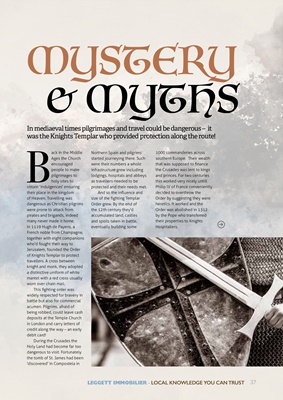
B
ack in the Middle
Ages the Church
encouraged
people to make
pilgrimages to
holy sites to
obtain 'indulgences' ensuring
their place in the kingdom
of Heaven. Travelling was
dangerous as Christian pilgrims
were prone to attack from
pirates and brigands, indeed
many never made it home.
In 1119 Hugh de Payens, a
French noble from Champagne,
together with eight companions
who'd fought their way to
Jerusalem, founded the Order
of Knights Templar to protect
travellers. A cross between
knight and monk, they adopted
a distinctive uniform of white
mantel with a red cross usually
worn over chain mail.
This fighting order was
widely respected for bravery in
battle but also for commercial
acumen. Pilgrims, afraid of
being robbed, could leave cash
deposits at the Temple Church
in London and carry letters of
credit along the way - an early
debit card!
During the Crusades the
Holy Land had become far too
dangerous to visit. Fortunately
the tomb of St. James had been
'discovered' in Compostela in
Northern Spain and pilgrims
started journeying there. Such
were their numbers a whole
infrastructure grew including
lodgings, hospitals and abbeys
as travellers needed to be
protected and their needs met.
And so the influence and
size of the fighting Templar
Order grew. By the end of
the 12th century they'd
accumulated land, castles
and spoils taken in battle,
eventually building some
MYSTERY
& MYTHS
In mediaeval times pilgrimages and travel could be dangerous - it
was the Knights Templar who provided protection along the route!
1000 commanderies across
southern Europe. Their wealth
that was supposed to finance
the Crusades was lent to kings
and princes. For two centuries
this worked very nicely untill
Philip IV of France conveniently
decided to overthrow the
Order by suggesting they were
heretics. It worked and the
Order was abolished in 1312
by the Pope who transferred
their properties to Knights
Hospitallers.
37
LEGGETT IMMOBILIER - LOCAL KNOWLEDGE YOU CAN TRUST